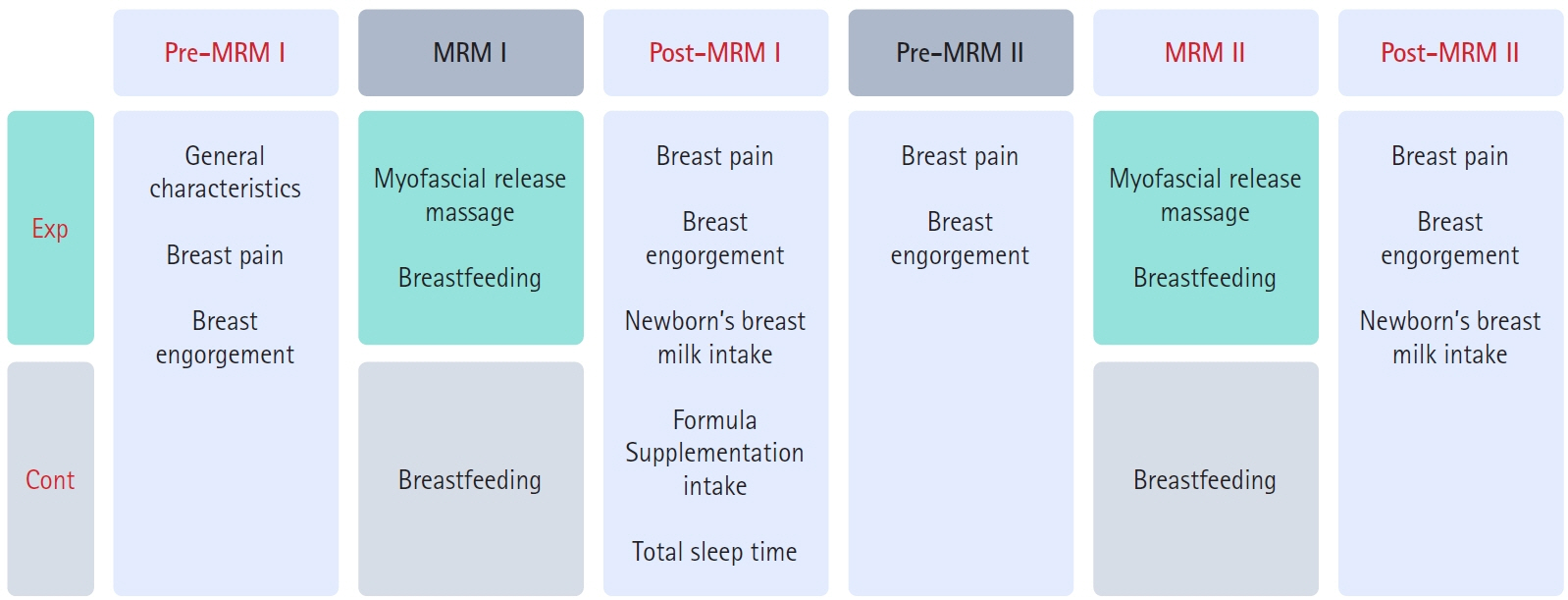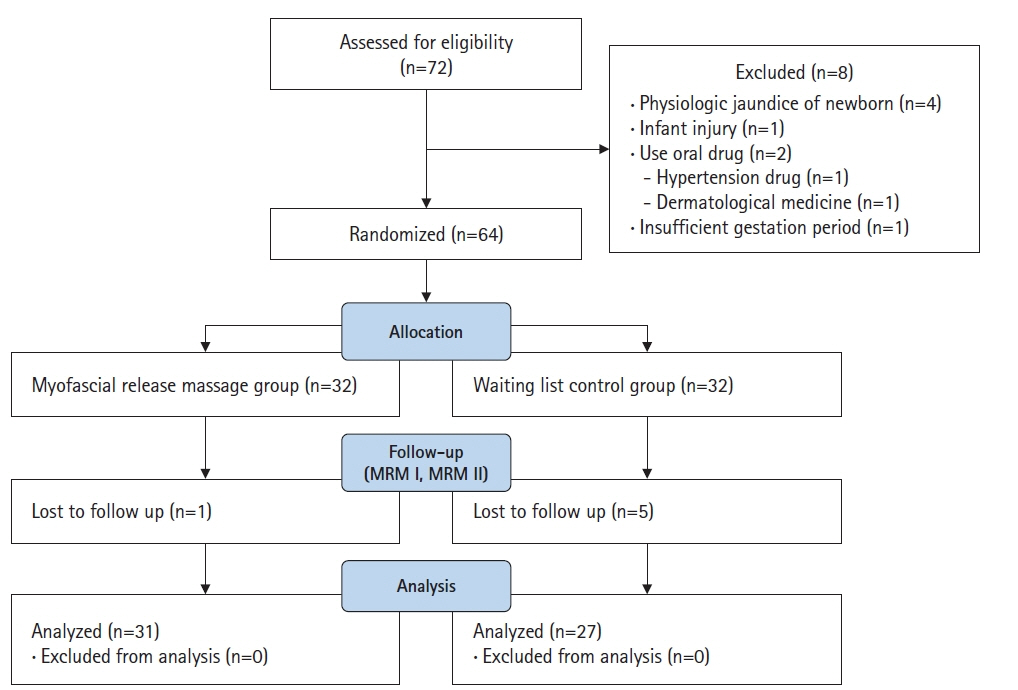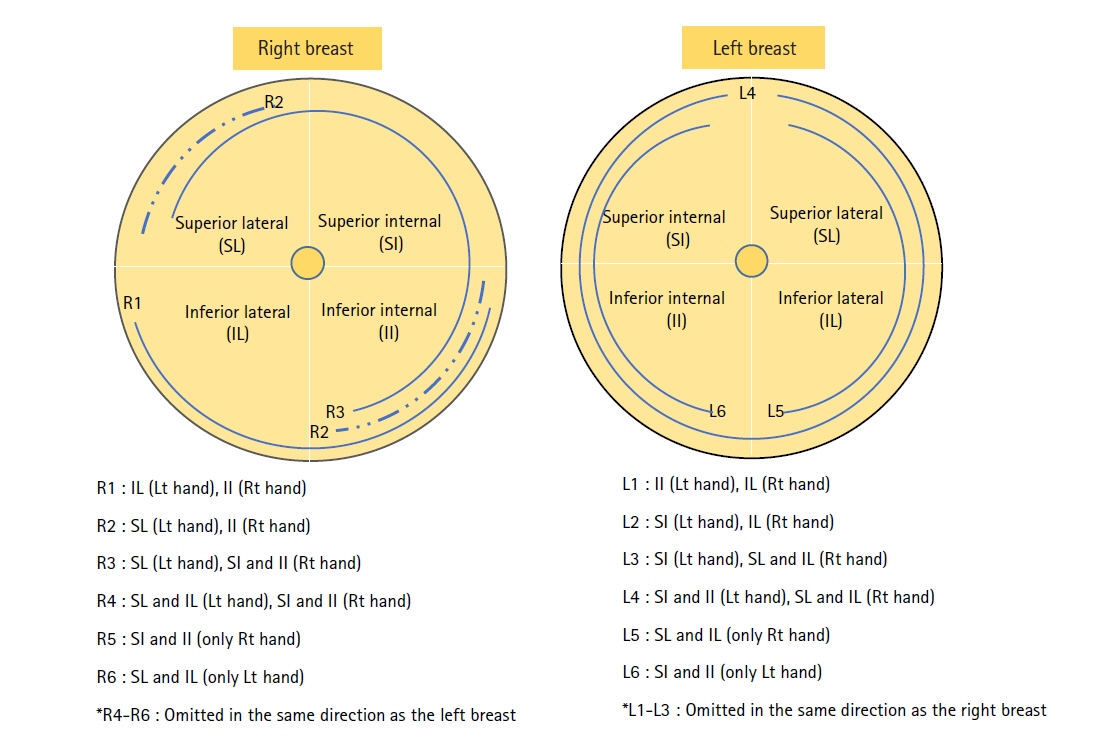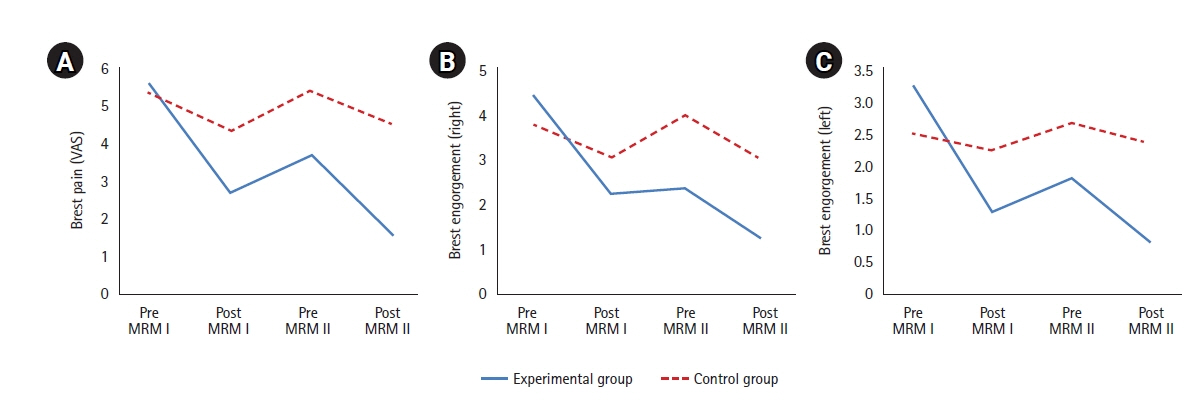Korean J Women Health Nurs.
2023 Mar;29(1):66-75. 10.4069/kjwhn.2023.03.15.
Effect of pectoralis major myofascial release massage for breastfeeding mothers on breast pain, engorgement, and newborns’ breast milk intake and sleeping patterns in Korea: a randomized controlled trial
- Affiliations
-
- 1Sanbon Branch of Mamslibe, Gunpo, Korea
- 2Department of Nursing, Chung Cheong University, Cheongju, Korea
- 3Department of Nursing, Kyung Min University, Uijeongbu, Korea
- 4College of Nursing, Eulji University, Uijeongbu, Korea
- KMID: 2543803
- DOI: http://doi.org/10.4069/kjwhn.2023.03.15
Abstract
- Purpose
Supportive interventions to improve breastfeeding practice are needed in nursing. This study investigated the effects of pectoralis major myofascial release massage (MRM) on breast pain and engorgement among breastfeeding mothers and on breast milk intake and sleep patterns among newborns. Methods: Breastfeeding mothers who had delivered between 37 and 43 weeks and had 7-to 14-dayold newborns were recruited from a postpartum care center in Gunpo, Korea. Participants were randomized to the MRM or control group. The outcome variables were breast pain and breast engorgement among breastfeeding mothers and breast milk intake and sleep time among newborns. The experimental treatment involved applying MRM to separate the pectoralis major muscle and the underlying breast tissue in the chest. After delivery, the first MRM session (MRM I) was provided by a breast specialist nurse, and the second (MRM II) was administered 48 hours after MRM I. Results: Following MRM, breast pain (MRM I: t=−5.38, p<.001; MRM II: t=−10.05, p<.001), breast engorgement (MRM I: right, t=−1.68, p =.100; left, t=−2.13, p=.037 and MRM II: right, t=−4.50, p<.001; left, t=−3.74, p<.001), and newborn breast milk intake (MRM I: t=3.10, p=.003; MRM II: t=3.09, p=.003) differed significantly between the groups. Conclusion: MRM effectively reduced breast engorgement and breast pain in breastfeeding mothers, reducing the need for formula supplementation, and increasing newborns’ breast milk intake. Therefore, MRM can be utilized as an effective nursing intervention to alleviate discomfort during breastfeeding and to improve the rate of breastfeeding practice (clinical trial number: KCT0002436).
Keyword
Figure
Reference
-
References
1. Schanler RJ. Outcomes of human milk-fed premature infants. Semin Perinatol. 2011; 35(1):29–33. https://doi.org/10.1053/j.semperi.2010.10.005.
Article2. Sosseh SAL, Barrow A, Lu ZJ. Cultural beliefs, attitudes and perceptions of lactating mothers on exclusive breastfeeding in The Gambia: an ethnographic study. BMC Womens Health. 2023; 23(1):18. https://doi.org/10.1186/s12905-023-02163-z.
Article3. Tran V, Reese Masterson A, Frieson T, Douglass F, Pérez-Escamilla R, O’Connor Duffany K. Barriers and facilitators to exclusive breastfeeding among Black mothers: a qualitative study utilizing a modified Barrier Analysis approach. Matern Child Nutr. 2023; 19(1):e13428. https://doi.org/10.1111/mcn.13428.
Article4. Pereira-Kotze C, Feeley A, Doherty T, Faber M. Maternity protection entitlements for non-standard workers in low-and-middle-income countries and potential implications for breastfeeding practices: a scoping review of research since 2000. Int Breastfeed J. 2023; 18(1):9. https://doi.org/10.1186/s13006-023-00542-8.
Article5. Miller EB, Whipps MD, Bogen DL, et al. Collateral benefits from a school-readiness intervention on breastfeeding: a cross-domain impact evaluation. Matern Child Nutr. 2023; 19(1):e13446. https://doi.org/10.1111/mcn.13446.
Article6. Prentice AM. Breastfeeding in the modern world. Ann Nutr Metab. 2022; 78 Suppl 2:29–38. https://doi.org/10.1159/000524354.
Article7. Kim HR. Breastfeeding trends, affecting factors and policy options for breastfeeding promotion in Korea. Health Welf Policy Forum. 2013; 201:49–60.8. Korean Health Promotion Institute, Ministry of Health and Welfare. National Comprehensive Plan for Health Promotion: breastfeeding rate at 6 months after birth: from Korean National Health and Nutrition Examination Survey [Internet]. Seoul: Author; 2020 [cited 2023 Mar 15]. Available from: https://www.khepi.or.kr/hpl/hplIdx/detailView.do?menuId=MENU00834&code_no=12001&sub_code_no=0&search_type=AND&subType=SUBJECT&idx_ix=285.9. Choi EJ; Korea Institute for Health and Social Affairs (KIHASA). Domestic breastfeeding survey 2016 [Internet]. Sejong: KIHASA; 2016 [cited 2023 Mar 15]. Available from: https://www.unicef.or.kr/data/upload/ebook/crc-publications/609/.10. Cho JS, Ahn SH. Development and evaluation of breastfeeding promotion program for mothers with breast engorgement following cesarean birth. J Korean Acad Nurs. 2014; 44(2):170–178. https://doi.org/10.4040/jkan.2014.44.2.170.
Article11. Eum GR, Sohn HS, Kim HY. Breastfeeding rate and related factors in Busan. J Korean Soc Matern Child Health. 2007; 11(1):78–85. https://doi.org/10.21896/jksmch.2007.11.1.78.
Article12. Chan SM, Nelson EA, Leung SS, Li CY. Breastfeeding failure in a longitudinal post-partum maternal nutrition study in Hong Kong. J Paediatr Child Health. 2000; 36(5):466–471. https://doi.org/10.1046/j.1440-1754.2000.00544.x.
Article13. Chung SH, Kim HR, Choi YS, Bae CW. Trends of breastfeeding rate in Korea (1994-2012): comparison with OECD and other countries. J Korean Med Sci. 2013; 28(11):1573–1580. https://doi.org/10.3346/jkms.2013.28.11.1573.
Article14. Song JA, Hur MH. A systematic review of breast care for postpartum mothers. Korean J Women Health Nurs. 2019; 25(3):258–272. https://doi.org/10.4069/kjwhn.2019.25.3.258.
Article15. Kernerman E, Park E. Severe breast pain resolved with pectoral muscle massage. J Hum Lact. 2014; 30(3):287–291. https://doi.org/10.1177/0890334414535842.
Article16. Schulz KF, Altman DG, Moher D; CONSORT Group. CONSORT 2010 Statement: updated guidelines for reporting parallel group randomised trials. BMC Med. 2010; 8:18. https://doi.org/10.1186/1741-7015-8-18.
Article17. Faul F, Erdfelder E, Buchner A, Lang A. G* Power (version 3.1. 9.2). Germany: University of Kiel; 2014.18. Kang KA, Lee JA, Hur MH. Effects of periodic breast massage on the cyclical mastalgia of fertile women before their menstrual period. J Korea Converg Soc. 2022; 13(3):353–362. https://doi.org/10.15207/JKCS.2022.13.03.353.
Article19. Gray JR, Grove SK. Burns & Grove’s the practice of nursing research: appraisal, synthesis, and generation of evidence. 9th ed. St. Louis, MO: Elsevier; 2021. p. 417-418.20. Thomas AA, Chhugani M, Thokchom S. A quasi-experimental study to assess the effectiveness of chilled cabbage leaves on breast engorgement among postnatal mothers admitted in a selected hospital of Delhi. Int J Nurs Midwif Res. 2017; 4(1):8–13. https://doi.org/10.24321/2455.9318.201702.
Article21. Demirci JR, Braxter BJ, Chasens ER. Breastfeeding and short sleep duration in mothers and 6-11-month-old infants. Infant Behav Dev. 2012; 35(4):884–886. https://doi.org/10.1016/j.infbeh.2012.06.005.
Article
- Full Text Links
- Actions
-
Cited
- CITED
-
- Close
- Share
- Similar articles
-
- Corrigendum: Effect of pectoralis major myofascial release massage for breastfeeding mothers on breast pain, engorgement, and newborns’ breast milk intake and sleeping patterns in Korea: a randomized controlled trial
- Development and Evaluation of Breastfeeding Promotion Program for Mothers with Breast Engorgement following Cesarean Birth
- Effects of Breast Massage on Breast Pain, Breast-milk Sodium, and Newborn Suckling in Early Postpartum Mothers
- Effect of Aromatherapy Massage on the Mood, the Milk ejection Reflex, and the Immunoglobulin A of the Breast Milk of Mothers with a Cesarean Section Delivery
- A Systematic Review of Breast Care for Postpartum Mothers





